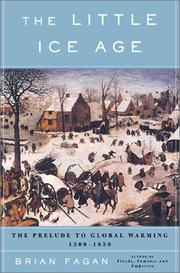Check nearby libraries
Buy this book

"The Little Ice Age, the most significant climate even of the last millennium, was sandwiched between two warm spells - the Medieval Warm Period, which lasted from about 900 to 1300 A.D., and the present global warming, which began in about 1850. Although climatologists long suspected the broad outlines of these periods, only within the past decade have they developed an accurate picture of climate conditions in historical times.
They can now determine yearly average temperatures and rainfall, the times and magnitude of volcanic eruptions, and even how brightly the sun shone centuries ago.".
"Fagan draws upon this research to show how the balmy weather of the Medieval Warm Period made first Iceland, then Greenland, attractive colonies for Norse expansion. Colder centuries ultimately led to the abandonment of Greenland, but colder ocean currents also forced vast shoals of cod, a staple food throughout Europe, into the western Atlantic Ocean.
English and Basque fishing fleets followed the cod down the coast of North America for centuries, making many temporary landings, before the Pilgrims made a permanent settlement on Cape Cod, with the mission "to praise God and to fish."".
"Storms, cold, and rain meant more crop failures for peoples already living a marginal existence. Until recently it took nine out of every ten workers in Europe just to grow enough to eat - and the deteriorating climate put their world under severe stress. By 1600, when the coldest two centuries of the Little Ice Age began, a worsening food crisis had been developing for nearly three centuries.
In Flanders and England, the response was an agricultural revolution that was a prelude to the Industrial Revolution. Ireland adopted the potato, an import from the Americas, so fervently that by 1800 Irish farmworkers ate almost nothing else - two generations later they would suffer the worst famine Ireland had ever known.".
"France adapted the least of all: It changed neither its farming methods nor its crops, and the continuing slow decline of living standards throughout the worst years of the Little Ice Age led to chronic near-famine and increasing crime, widespread social breakdown, and ultimately chaos and revolution. The Industrial Revolution, the French Revolution, and the Irish Potato Famine were all partly brought on by climate change.".
"In viewing history through the lens of climate, The Little Ice Age brings together a huge range of sources, from the dates of long-ago wine harvests and the business records of 14th century monasteries to the latest chemical analysis of ice cores. Fagan weaves this information into a story that will fascinate anyone interested in history, weather, and how the two interact."--BOOK JACKET.
Check nearby libraries
Buy this book

Previews available in: English
Subjects
Climatic changes, HistoryPlaces
EuropeShowing 1 featured edition. View all 1 editions?
| Edition | Availability |
|---|---|
|
1
The Little Ice Age: How Climate Made History 1300-1850
December 26, 2000, Basic Books
in English
0465022715 9780465022717
|
aaaa
Libraries near you:
WorldCat
|
Book Details
First Sentence
"The fog lies close to the oily, heaving water, swirling gently as a bitterly cold air wafts in from the north."
Classifications
ID Numbers
Source records
amazon.com recordLibrary of Congress MARC record
Ithaca College Library MARC record
Library of Congress MARC record
marc_openlibraries_phillipsacademy MARC record
marc_openlibraries_sanfranciscopubliclibrary MARC record
Internet Archive item record
Library of Congress MARC record
Internet Archive item record
marc_columbia MARC record
Community Reviews (0)
Feedback?| July 15, 2024 | Edited by MARC Bot | import existing book |
| August 3, 2020 | Edited by intuitia | author |
| February 6, 2019 | Created by MARC Bot | import existing book |










